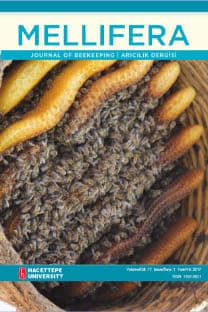The Effects of Environmental Problems on Honey Bees in view of Sustainable Life
Sosyal ve ekonomik kalkınmaya paralel olarak yaşanan çevre sorunları nedeniyle doğanın dengesi ve sürekliliği her geçen gün bozulmaktadır. Bugün, bu artış doğanın binlerce yıllık birikiminin bir sonucu olarak ortaya çıkan muhteşem yaşam döngüsünü tehdit etmektedir. Doğal kaynakların aşırı ve bilinçsiz tüketimi ve artan dünya nüfusunun bir sonucu olarak doğanın dengesi bozulmaktadır. Bal arılarının ekosistemdeki önemi tartışılmazdır. Bal arıları bitkilerin tozlaşmasına yardımcı olur, verimi arttırır ve tarımsal ekosisteme önemli katkılarda bulunurlar. Ancak, pestisitler, tarımda kullanılan kimyasallar, bal arısı zararlıları ve hastalıklarla mücadelede kullanılan kimyasallar, çevre kirliliği, bal arıları arasındaki rekabet ilişkileri, radyasyon, iklim değişikliği, küresel ısınma ve koloni çökme sendromu (CCD) bal arılarının yaşamını tehdit etmektedir. Bu nedenle, çevre sorunlarını ve bunların bal arıları üzerindeki etkilerini daha iyi anlamak ve konuyla ilgili önlemleri hızlı bir şekilde belirlemek gerekmektedir.
Keywords:
Honey bee, environmental problems,
___
- [1] GALLAI, N; SALLES, J M; SETTELE, J; VAISSIAE, B E (2009) Economic valuation of the vulnerability of World agriculture confronted with pollinator decline. Ecological Economics, 68: 810-821. [2] AIZEN, M A; GARIBALDI, L A; CUNNİNGHAM, S A; KLEIN, A M (2009) How much does agriculture depend on pollinators? Lessons from long-term trends in crop production. Annals of Botany, 103: 1579-1588. [3] MORANDIN, L A; WINSTON, M L (2006) Pollinators provide economic incentive to preserve natural land in agro-ecosystems. Agriculture, Ecosystems&Environment, 116: 289-292. [4] HENRY, M I; BEGUIN, M; REQUIER, F; ROLLIN, O; ODOUX, J F; AUPINEL, P; APTEL, J; TCHAMITCHIAN, S; DECOUURTYE, A (2012) A common pesticide decreases foraging success and survival in honey bees. Science, 336 (6079): 348-350. [5] THOMPSON, H M (2012) Interaction between pesticides and other factors in effects on bees. EFSA supporting Publications, EN-340, 204pp. Available from: http://www.efsa.europa.eu/publications [6] GILL, R J; RAMOS-RODRIGUEZ, O; RAINE, N E (2012) Combined pesticide exposure severely affects individual and colony level traits in bees. Nature, 491: 105-108. [7] POTTS, S G; BIESMEIJER, J C; KREMEN, C; NEUMANN, P; SCHWEIGER, O; KUNIN, W E (2010) Global pollinator declines, trends, impacts and drivers. Trends in Ecology & Evolution, 25: 345-353. [8] YUCEL, B; MATIN, G; KARGAR, N (2014) Survey of honey bees and bee products for monitoring environmental pollution. In International Congress on “Green Infrasturucture and Sustainable Socities/Cities” GreInSus’14, Izmir, Turkey, May 8-10 2014, P 200. [9] BRITTAIN, C; KREMEN, C; KLEIN, A M (2013) Biodiversity buffers pollination from changes in environmental conditions. Global Change Biology, 19: 540-547. [10] BIESMEIJER, J C; ROBERTS, S P M; REEMER, M; OHLEMÜLLER R; EDWARDS M; PEETERS T; SCHAFFERS, A P; POTTS, S G; KLEUKERS, R; THOMAS, C D; SETTELE, J; KUNİN, W E (2006) Parallel declines in pollinators and insect-pollinated plants in Britain and the Netherlands. Science, 313: 351-354. [11] MEMMOTT, J; CRAZE, P G; WASER, N M; PRICE, M V (2007) Global warming and the disruption of plant-pollinator interactions. Ecology Letters, 10: 710-717. [12] KEVAN, P G (1999) Pollinators as Bio-indicators of The State of The Environment: Species, Activity and Diversity. Agriculture, Ecosystems & Environment, 74(1-3): 373-393. [13] CELI, G; MACCAGNANI, B (2003) Honey bees as bio-indicators of environmental pollution. Bulletin of Insectology, 137-139. [14] KENCE, A; ASLAN, O C; KAYIM, M; TOZKAR, O; KUKRER, M; YUCEL, B; DOGAROGLU, M; MUZ, M; GIRAY, T; KENCE, M (2010) The survey combining the COLOSS questionnaire and the questionnaire prepared for colony losses in Turkey. COLOSS Workshop of Standardized Protocols for Honey bee Vitality and Diversity. In Aarhus University, Denmark, June 16-18 2010.P 7. [15] WILLIAMS, G R; TARPY, D R; VANENGELSDORP, D; CHAUZAT, M P; COX-FOSTER, D L; DELAPLANE, K S; NEUMANN, P; PETTIS, J S; ROGERS, R E L; SHUTLER, D (2010) Colony Collapse Disorder in context. BioEssays, 32: 845-846. [16] APENET (2011) Effects of coated maize seed on honey bees. Report based on results obtained from the third year activity of the APENET Project. [17] DECOURTYE, A; ARMENGAUD, C I; RENOU, M; DEVILLERS, J; CLUZEAU, S; GAUTHIER, M; PHAM-DELEGUE, M H (2004) Imidacloprid impairs memory and brain metabolism in the honey bee (Apismellifera L.). Pesticide Biochemistry and Physiology, 78: 83-92. [18] ALAUX, C; BRUNET, J L; DUSSAUBAT, C; MONDET, F; TCHAMITCHAN, S; COUSIN, M; BRILLARD, J; BALDY, A; BELZUNCES, L P; LE CONTE, Y (2010) Interactions between Nosema microspores and a neoicotinoid weaken honeybees (Apismellifera). Environmental Microbiology, 12: 774-782. [19] EASTON, A H; GOULSON, D (2013) The neonicotinoid insecticide imidacloprid repels pollinating flies and beetles at field-realistic concentrations. PLoS ONE, 8:e54819.
- ISSN: 1302-5821
- Başlangıç: 2001
- Yayıncı: Hacettepe Üniversitesi
Sayıdaki Diğer Makaleler
Bioactive Properties of Blossom and Honeydew Honeys
Assia HABBI-CHERIFI, Noureddine ADJLANE, Ferroudja MEDJDOUB-BENSAAD, Nizar HADDAD
Chemical Content and Bioactive Properties of Drone Larvae (Apilarnil)
Assia HABBI-CHERIFI, Noureddine ADJLANE, Ferroudja MEDJDOUB-BENSAAD, Nizar HADDAD
Özgür PİRGON, Müge ATAR, Metin ÇİRİŞ, Murat SEVER
The Effects of Environmental Problems on Honey Bees in view of Sustainable Life
Effects of Royal Jelly Supplementation on Growth Plate Zones and Longitudinal Growth in Young Rats
